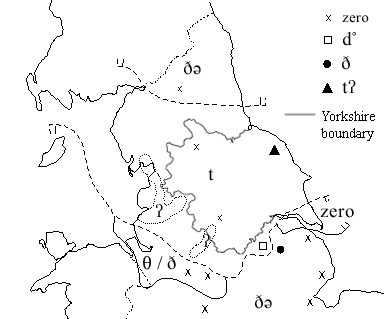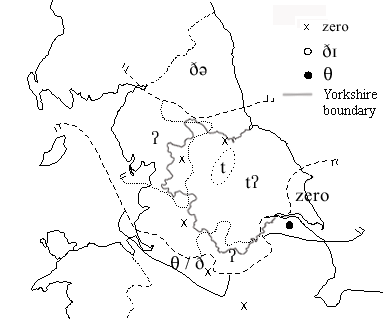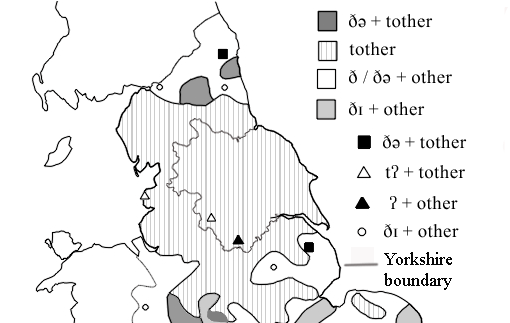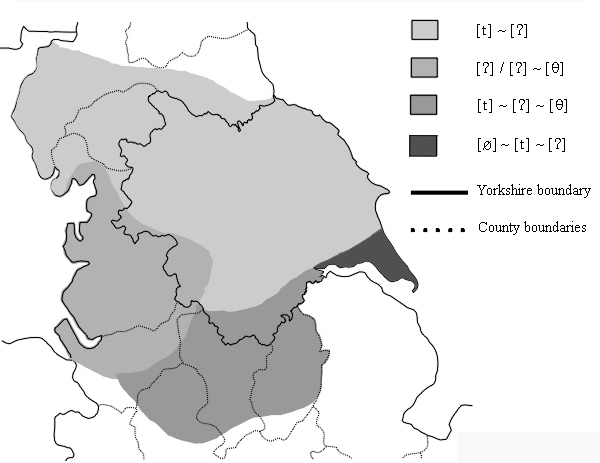


|
|
 |
|
| "The area affected by [Definite Article Reduction] covers all northern English counties with the exception of Northumberland and some parts of Durham. The counties included are the historic counties of Yorkshire and Lancashire and all counties as far south as Cheshire, northern Staffordshire and northern Nottinghamshire." (Jones, 1998: 103) |
The following material is drawn principally from two studies (Barry, 1972 and Jones, 1998) both of which investigate the phonological environments affecting the various realizations of Definite Article Reduction (DAR). However, whilst Barry's analysis focuses on the Basic Material (and to some extent on the incidental material) from the Survey of English Dialects (SED) Jones uses the actual sound recordings.
Before commencing with Barry's findings there are a few brief observations about the varieties of DAR.
Variations in DAR
Jones (1998) notes that in dialect literature the reduced form of the article
is commonly represented as either t' or th'. He cites the following
example from Wuthering Heights:
"T' maister's down i' t' fowld. Go round by th' end ot' laith, if you want to spake to him." (Brönte, 1847: 24)
However, this is an oversimplification of the situation. Although there is no existing phonetic description of the phenomenon Jones (1998) identifies the following variations found within the SED:
Table 1
|
[
|
[
|
[
|
[
|
[
|
[
|
[
|
[
|
|
[
|
[
|
[
|
[
|
[
|
[
|
[
|
[
|
|
After Jones 1998:104 |
Furthermore, Jones adds, that although more than one realization occurs in most
localities (Table 2). DAR is not employed exclusively. The standard form is
also used (for examples, see the SED incidental material for locations Y2, 7,
16 and 22).
Table 2
| Location | Realization |
| West Yorkshire | [t] / [ |
| North-east Yorkshire | [d] / [t] |
| North-west and east Yorkshire | [d] / [t] / [ |
|
After Wright 1905, cited by Jones, 1998 |
Whilst it seems clear that this variation in realization may be attributed to the phonological environment, the question arises as to whether it is the preceding or following segment which is the conditioning factor. According to Jones, it is the second which has predominated since Wright (1905). The latter took the view that the conditioning factors were succeeding "word initial vowels, dentals and other consonants". In his analysis of the morphemic distribution of the definite article in Modern English Barry (1972) takes up this notion.
| allomorph: term used to describe any variant
of a single phoneme. For example, in English, <a> is nasalized (realized
as [ |
The Barry Study
Barry examines the occurrence of the definite article in relation to four linguistic
environments: preceding an initial vowel, before an initial consonant, prior
to initial [t]), and the + other. Although Barry is concerned
with the forms of the article across all the English counties, the following
details of his findings are confined to the north and, in particular, Yorkshire.
Where appropriate, details of phonetically related allomorphs
are given together with occurrences of standard forms of the article
The preceding an Initial Vowel
Map 1 is based solely on the responses to the SED question V.6.6., "Where
do you bake the bread?" (In the oven) the object of which was to
establish the form of the definite article when it preceded an initial vowel.
Map 1
 |
After Barry 1972: 168 |
The vast majority of Yorkshire falls within the [t] area, the northern borders of which runs from the Solway Firth, passing south of Carlisle before travelling east to the locality within which the borders of Westmoreland, Cumberland and Northumberland converge. Thereafter the border proceeds to the south, bypassing Wearhead in Co Durham, before progressing east to the North Sea. The southern border commences to the north of Man and cuts through Lancashire north of Fleetwood to the border of Yorkshire. It then heads south-south-east avoiding Heptonstall (Y21) Golcar (Y29) and Holmbridge (Y30), before turning south to include two localities in Nottinghamshire and north-eastern Derbyshire. Thereafter it moves towards, and keeps to the line of the Humber estuary before heading sharply to the north-east and onwards to the North Sea (excluding Holderness). Exceptionally, examples of [t] do occur outside this area (e.g. Golcar, Y29) but solely in the SED incidental material.
Barry draws attention to the fact that [t] has a number of phonetically related allomorphs a summary of which is contained in Table 3.
Table 3
| Allomorph | Location | SED No | Comment |
| [ |
Newbald (ER) |
Y25
|
Also appears in incidental material at Y11 and 20 in the Wolds. |
| [ |
Sheffield (WR) |
Y34
|
No other locations |
| [ |
South-west of the county - see Map 1 |
-
|
These allomorphs are widespread in the southwest of Yorkshire. [t] and [D] also appear in this area in the incidental material. The same data also demonstrates occurrences of the glottalised allomorph at Y2 and 9. |
| [ |
Spread throughout the region |
-
|
More commonly found in incidental material e.g. Y21, 29 and 30. |
| [t |
Western part of the West Riding only |
-
|
Barry suggests that this allomorph is a trade-off originating from a "blurring of the boundaries" between the areas of the dental fricative [T] and the alveolar plosive [t]. |
| zero | Holderness only |
Y28
|
Present in Y11, 20 and 25 in the incidental material with further isolated occurrences at Y7, 22 and 31. |
|
After Barry 1972: 169 |
In relation to the standard forms, occurrences are found only in the incidental material with incidences of [DI] at Y2, 7,16 and 22.
The preceding an Initial Consonant
Map 2 is founded exclusively on the responses to SED question IX.2.3. "In
summer you don't water your garden in the middle of the day; you wait [g. the
sun going down]….till the sun goes down".
Map 2
 |
After Barry 1972: 175 |
Again [t] is seen to predominate within a distinct region of northern England (mostly Yorkshire). The locations of phonetically related allomorphs are given in Table 4.
Table 4
| Allomorph | Location | SED No | Comment |
| [ |
-
|
-
|
Occurs only in incidental material for Y6 |
| [ |
Holmbridge (WR) |
Y30
|
The only example in the responses |
| [t |
Egton (NR) |
Y4
|
The only example in the responses |
| [ |
-
|
-
|
Occurs only in incidental material for Y30 |
| zero | Holderness only |
Y28
|
Isolated cases occur at Y6 and 26 |
|
After Barry 1972: 173 |
Commenting on the glottalized forms, Barry draws attention to the fact that
the incidence and geographic density is much greater in the incidental material.
Moreover, the greatest number of occurrences are found in the West Riding. A
sprinkling of [t![]() ] is found
in the northeastern and northwestern areas of the county. However, in contrast
to the the + vowel combination, no glottalized forms are found in the
southwest of the county apart from in the incidental material.
] is found
in the northeastern and northwestern areas of the county. However, in contrast
to the the + vowel combination, no glottalized forms are found in the
southwest of the county apart from in the incidental material.
With regard to standard forms Barry notes that, in relation to the [t] area,
[![]() ] forms are evident only
in the SED incidental material. Nevertheless, they are more generally pervasive
therein than in the responses to SED question V.6.6 (see the + vowel
above), the greatest concentration being in the West Riding and in the north
of the county. Barry theorizes that the prevalence of the standard form in the
SED localities bordering the main [
] forms are evident only
in the SED incidental material. Nevertheless, they are more generally pervasive
therein than in the responses to SED question V.6.6 (see the + vowel
above), the greatest concentration being in the West Riding and in the north
of the county. Barry theorizes that the prevalence of the standard form in the
SED localities bordering the main [![]() ]
areas (map 2) suggests the possibility of an incursion of the standard form,
particularly into relation to the West Riding.
]
areas (map 2) suggests the possibility of an incursion of the standard form,
particularly into relation to the West Riding.
The before an initial [t]
Replies to SED question V.8.12. "When you put things on the table ready for
a meal, what do you say you do?" (To lay the table.) form the basis of
Map 3.
Map 3
 |
|
After Barry 1972: 175 |
In terms of the + initial t no incidental material exists in
relation to this question. In the case of the [t] form, this is only found at
Y3, 8 and 15 with the remaining locations manifesting the glottalized forms
of [![]() ] and [t
] and [t![]() ].
Barry observes that the area boundaries of these latter forms reflect almost
exactly those of the [t] area shown in Map 2.
].
Barry observes that the area boundaries of these latter forms reflect almost
exactly those of the [t] area shown in Map 2.
The preceding Other
Map 4 relates only to the responses to part (b) of the SED question IX.8.8.
(a) "You cut an apple in half, and to your little girl you give [g.] …
one half, (b) and to your boy you give {g.] … the other."
Map 4
 |
|
After Barry 1972: 176 |
As can be seen the predominating form is tother occurring both with and without the definite article. Barry assumes that this form derives from the erroneous syllabic separation of Old English þæt oþer, i.e. it became þæ toþer following which the syllable þæ- became redundant. A number of SED informants in fact regarded tother to be a word in it's own right. With regard to Yorkshire the following is noted:
Barry concludes by stating that, whilst the SED material forms the basic framework of the research into the definite article, additional in-depth investigation is required in order to provide further data.
The Jones Study
From the SED recordings Jones (1998) identifies in excess of 2000 incidences
of DAR across 63 locations. After the exclusion of ambiguous phonetic environments
1800 were used for his study. For the purposes of the analysis Jones makes distinction
between plosive ([t], [d] etc) and what he terms laryngeal realizations (i.e.
realizations usually symbolized by the IPA character [![]() ],
e.g.[
],
e.g.[![]() ],
[
],
[![]() ] etc.). Forms such
as [
] etc.). Forms such
as [![]() ]
he classifies as plosives. Thus, for example, " fetched the horse"
(fetched t'horse) might be either:
]
he classifies as plosives. Thus, for example, " fetched the horse"
(fetched t'horse) might be either:
| Laryngeal articulation |
| or |
| Plosive articulation |
Map 5 summarises the position in relation to Jones' findings. With regard to
geographical distribution he notes that laryngeal forms were present at all
locations and that the [t] ~ [![]() ]
variation is the most widespread.
]
variation is the most widespread.
Map 5
 |
|
After Jones 2004 |
In his 2004 study he highlights the fact that these varieties also alternate
with the zero form found in Holderness. Another point of interest in terms of
phonological variation is evident within the [t] ~ [![]() ]
area. In effect, identical phonological environments generate different articulations
in different locations. For example, in an n_ r environment as exemplified by
"in the road" the realization might be either [
]
area. In effect, identical phonological environments generate different articulations
in different locations. For example, in an n_ r environment as exemplified by
"in the road" the realization might be either [![]() ]
or [
]
or [![]() ]. Jones (1998) theorizes
that such variance may arise out of distinct phonological processes such as
assimilation or lenition. He notes for example that the "lenition of syllable
final [t] to [
]. Jones (1998) theorizes
that such variance may arise out of distinct phonological processes such as
assimilation or lenition. He notes for example that the "lenition of syllable
final [t] to [![]() ] is common
in British English dialects". For further details see Jones (1998: 118).
] is common
in British English dialects". For further details see Jones (1998: 118).
Consonant clusters also appear to some impact on choice of DAR form. Although
word-initial clusters within the recorded material are rare Jones found among
other things that some localities in the [t] ~ [![]() ]
area have [t] before simple segments? (e.g. vowel _ s) but [
]
area have [t] before simple segments? (e.g. vowel _ s) but [![]() ]
before clusters (e.g. vowel _ st).
]
before clusters (e.g. vowel _ st).
Jones (1998) concludes by expressing some reservations about this study both with regard to the SED data and his findings based thereon. He is mindful of the fact that the SED material was not collected specifically for the purposes of investigating DAR. One outcome of this is that the range of phonetic environments is relatively limited and therefore barely adequate for this type of study. In Jones' own words "the data raises more questions than it answers". He expresses the view that any future investigations of the DAR phenomenon should employ data collected for the express purpose of "phonological and phonetic analysis".
It is clear from the above that there is yet much to do apropos the investigation of DAR. Both Barry and Jones agree that more data is required in order to reach any firm conclusions. The question is whether such a survey would have to be on the same scale as the SED and whether any institution or organisation would be willing to provide the necessary funding and personnel to carry out the task.
Sources
Barry, M. V. (1972) The Morphemic Distribution of the Definite Article in
Contemporary Regional English. In M. F. Wakelin (Ed) Patterns in the
Folk Speech of the British Isles, (1972) London: The Athlone Press.
Brönte, Emily. 1847. Wuthering Heights, Penguin Classics Edition. 1994.
Jones, M. J. (1998) The Phonology of Definite Article Reduction. In Clive Upton and Katie Wales (eds), Dialectal Variation in English: Proceedings of the Harold Orton Centenary Conference 1998, Leeds Studies in English, XXX: 103-122.
Jones, M. J. (2002) The origin of Definite Article Reduction in northern English dialects: evidence from dialect allomorphy. English Language and Linguistics 6.2: 325-345.
Jones, Mark J. (2004). The phonetics and phonology of Definite Article Reduction in northern English dialects. Unpublished PhD dissertation, University of Cambridge
Wright, J. (1905) English dialect Grammar, Oxford: Oxford University Press